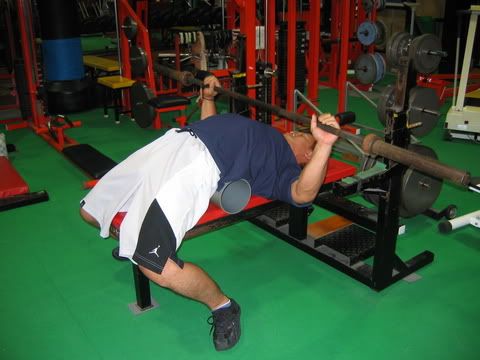
A few summers ago, I had the opportunity to visit a small gym in rural Japan called "Takei Power Gym".
I learned of this gym from my wife. She normally has no interest whatsoever in powerlifting, but noticed an article in the paper about a young girl who was a world record holder in the bench press, living and training in the same prefecture. The girl's father was her coach and the gym owner.
I went, not knowing what to expect exactly, but hoping that I might some tips for my horrible bench.
The first thing I noticed was everyones' outside shoes in the entryway... Oops, I was already wearing the shoes I was expecting to train in. I ended up taking them off, taking them to the changing room and rinsing off the soles before beginning my workout.
The gym itself is pretty bare-bones. Three extremely sturdy benches w. safety bar attachments, one power rack, a deadlift platform and loader, a few assorted machines, dumbells, stationary bicycle, treadmill, and a TV. One thing in particular catches my eye - three pieces of large diameter PVC tubing ranging in diameter from 3 - 10 inches. I know it is for one thing - to develop the arch that Japanese benchers are so famous for.
Ai Takei, a former IPF Junior world bench press record holder, is a thin girl, 5'2" maybe 105 pounds. Her father, took third place in the IPF Worlds Bench Press Championships in 1995. He is a very thick man, probably 5'5" and weighing about 220. They are both very friendly, modest people.
During the two sessions that I spent at Takei Power Gym, I talked with Ai and her father (both also Karate instructors by the way) a lot about training, equipment, and technique. Her are some of the highlights:
*Crain bench press shirts are a lot more popular here. According to Mr. Takei, Japanese benchers just don't like extreme gear. He has always used Crain bench shirts and loves the fit. He tried competing in an Inzer EHPHD, but hated it. I tell him that, for Americans, the more painful the gear, the better - he just laughs and it's pretty clear he doesn't agree.
*Almost all meets follow IPF guidelines, so everything is single-ply poly. The Rage X, when I visited, wasn't being sold in Japan yet. He mentions the F-6 too, but I didn't ask him follow-up questions about it.
*Japanese benchers maximize bench grip width. As soon as I put my hands on the bench, both Ai and her father immediately mention that Americans tend to bench close grip and they are a bit puzzled why they do that.
*Mr. Takei does a lot of rep work in the off-season, usually in the 8-10 range. Pre-contest work generally starts 8 weeks out with the last three weeks using equipment. His athletes usually do no workouts 10-14 days before a meet so they are fully recovered.
*His benchers take a lot of time to recover in-between sets. He recommends 10 minutes.
*He recommends an elbows-out bench press style. I know, I know... I mention rotator cuff injuries and he says that he has had a few, but that the shoulder and pectorals are underutilized by elbows-in benchers and that tricep-dominant lifters are limiting themselves. He says that opening up your elbows even a little will make a big difference with your bench press.
*They use large diameter PVC to help develop their arch. When I try using a 5" diameter tube, my back immediately cracks and then starts in with mild shooting spasms... I eventually settle into it and later, without the PVC, when I set myself with the bar, Mr. Takei pushes my shoulders towards my feet, saying "Down, down!". My upper back immediately tightens, solving an upper back tightness issue I've been battling on the bench press for years!
*I mentioned Westside and Metal Militia to Mr. Takei and he apparently was not aware of their methods. I don't know if Westside and Metal Militia methods have caught on in Japan since my visit or not.
*They don't do board presses, use bands or chains, do floor presses. Everything is pretty basic.
*Most of their off-season basic training is fairly high rep work (10-6). Training sets are determined by hitting a goal set and then subsequent drop sets are determined by performance in those sets. I can't remember the %s exactly, but basically the main set was a set of 10 and then subsequent sets were reduced reps or poundages from there.
Some time after visiting Takei's gym, I bought The Naked Warrior by Pavel Tsatsouline and it was nice to see someone echoing the same karateka techniques I learned in Japan.




No comments:
Post a Comment